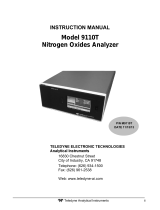
Symptom Possible Cause Remedy
Indicator light does not turn
on.
Unit is not connected to power source, or is
connected to improper power source.
Refer to label on side of chassis for voltage/frequency
requirements.
Connect unit to proper power source.
Safety Interlock Switch is not
engaged by chassis lid.
Remove lid. Bend “up” interlock arm.
Fuse is blown. Visually inspect unit, and compare to wiring diagram.
Inspect Corona Discharge Cell for damage. Inspect
wire from High Voltage Transformer to Corona Dis-
charge Cell for disconnection or burn marks. Repair
any and all problems prior to placing unit in service, or
contact factory for service information.
Light is not receiving power. Connect light leads to power source per wiring dia-
gram.
Light has failed Refer to Spare/Replacement Parts for replacement
part information.
Unit keeps blowing fuses. Electrical short circuit. Visually inspect unit, and compare to wiring diagram.
Inspect Corona Discharge Cell for damage. Inspect
wire from High Voltage Transformer to Corona Dis-
charge Cell for disconnection or burn marks. Repair
any and all problems prior to placing unit in service, or
contact factory for service information.
Incorrect fuse value and type are being
used.
Compare fuse to label on side of unit. Replace with
appropriate size/type fuse. Refer to Spare/Replace-
ment Parts for replacement part information.
Unit is connected to improper power
source.
Refer to label on side of chassis for
voltage/frequency requirements.
Corona Discharge Cells were not installed. Install per Installation Manual. (Corona Discharge
Cells are shipped in a separate container to avoid
damage).
Corona outside of the Cell/Manifold has
established due to dirt or moisture within
chassis. Corona Discharge Cell is in need of
maintenance.
Perform Corona Discharge Cell maintenance and
Chassis maintenance in accordance with this manual.
Unit does not produce adequate
concentration of ozone.
Air ow rate is too high. Adjust air ow meter to lower setting, within range
specied in Air Flow Specication section of this
manual.
Unit is running too hot due to insucient
cooling air ow.
Refer to Air Flow Specication section of this manual.
Unit is connected to improper power
source.
Refer to label on side of chassis for voltage/frequency
requirements.
Unit does not produce adequate
concentration of ozone, even with
air ow rate set at levels that pre-
viously produced adequate ozone
concentration.
Corona Discharge Cells require mainte-
nance.
Refer to Corona Discharge Cell Maintenance Section
of this manual.
Air preparation device is not functioning at
prior level of performance.
Inspect/Maintain air preparation equipment in accor-
dance with manufacturer recommendations.
9.0 Troubleshooting Guide
Troubleshooting should be performed by a qualied electrician, in accordance with sound electrical safety
practices.
19























